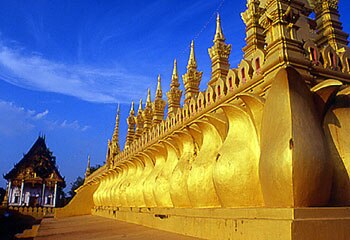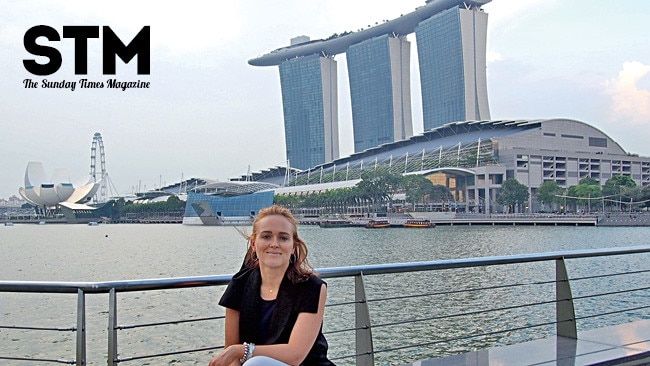In the arms of Buddha
CAPTURE the charm of Laos before it's too late, writes Trevor Seymour of a country where traditional ways are only slowly giving ground to the modern world.

THE temperature is almost 30C and the sun has not yet risen as I drag myself out of bed and set off to "feed the monks".
In the pre-dawn, the normally bustling streets of central Luang Prabang in northern Laos are silent except for the distant sounding of gongs from a number of Buddhist monasteries.
I make my way to one of the main intersections in the heart of town and, shortly after 6am, the first Buddhist monk appears through the hazy light. He is a wizened old man with grey hair, bare feet and a heavily lined face.
He heads a line-up of monks that stretches back hundreds of metres.
As he approaches the kneeling crowd, this clearly very important individual slows, adjusts his brilliant orange robe and then whips the lid off an elaborate bowl he is carrying by a shoulder strap and begins to collect small offerings of food from the kneeling faithful.
For the next 10 minutes hundreds of monks of all shapes, sizes and ages file past in silence, collecting food before going their separate ways to the many other monasteries.
It is a moment of enormous peace that is over far too soon, but it is also typical of the many surprises that await visitors to a South-East Asian country where traditional ways and practices are only slowly giving ground to the modern world.
Communist-ruled since 1975 when the Communist Pathet Lao ousted a six century-old monarchy, Laos does not have the frenetic pace of some its neighbours such as Thailand, Vietnam and Cambodia.
At the junction of the Mekong and Khan rivers, Luang Prabang was the traditional royal capital of Laos until the coup shifted the seat of power to the much larger Vientiane.
Tourism has taken a long time to gain momentum in one of the world's most undeveloped countries, closed to the outside world until 1986.
Luang Prabang boasts 66 wats (Buddhist temples) and some of the best examples of French colonial buildings in Indochina, and in recognition of this was added to UNESCO's World Heritage List in 1995.
The elaborate temples in what is called "the City of Monks" are simply stunning in all their multi-coloured glory, while the centre is remarkably well preserved and thankfully remains free of fast-food franchises.
Architecture aside, the most wondrous thing about Laos is the people. Whether it is the energy-sapping heat or their gentle nature, Laotians are happy, gentle and beautiful souls.
A good example of this is the wonderful open-air night market that stretches the length of Sisavangvong Rd in Luang Prabang.
A huge array of woven silks is on sale, together with clothes, hand-painted lamp shades and local crafts.
Unlike other countries, the vendors don't aggressively tout for business.
All are happy to chat and smile and won't pursue you down the street if you don't buy.
While the many temples offer delights, visitors should not miss taking in the Royal Palace Museum.
Boasting neatly tended gardens – the grass is cut with scythes rather than noisy lawnmowers – it has a hoard of ancient treasures and artefacts from the deposed monarchs.
Another highlight is to hike Mt Phousi in the centre of town. More a large hill than mountain, on a clear day it offers spectacular views across the region and is also home to a huge reclining Buddha statue.
It is easy to become fixed in the one spot eating delicious $5 meals, drinking large bottles of the local beer for $1 and watching life pass by, but getting out of town gives a view of the less sanitised parts of a country and how the majority of people live.
A 30km trip to the Tad Kuang Si waterfalls covers some spectacular countryside scattered with small rice paddies and thickly timbered hills.
It also clearly illustrates how poor Laos is, with peasants still planting rice fields with wooden ploughs behind the family cow.
Probably the most popular trip out of Luang Prabang is a boat ride up the Mekong River to the Pak Ou Caves in huge limestone cliffs. The muddy Mekong is shallow in parts in this area, but remains a vital lifeline for the locals.
Small junks carry freight and timber between towns and many fisherman make their living along the shores. The Pak Ou Caves are about 25km upstream and house more than 4000 Buddha statues placed there by worshippers.
Several plaques commemorate the work done by an Australian team in the early 1990s renovating the upper cave complex that requires a heart-starting hike up hundreds of steps to near the top of the limestone cliffs.
Boats often stop at several of the smaller villages on the trip where locals make a living from weaving silk or making potent rice whisky.
Luang Prabang offers a wide range of accommodation for all budgets, ranging from a few dollars to hundreds per night.
One of the best hotels in the top end of the market is the newly opened Maison Souvannaphoum.
Part of the Banyan Tree chain, it is a boutique, four-star hotel with 22 rooms and suites and is set in a colonial style building that was, until the 1970s, the royal residence of Prince Souvannaphoum.
Next door is the Wat Ho Xeing monastery, where I meet novice Monk Phetpasert Valhovong, 18, who invites me to visit the room he shares with two other monks. Their accommodation is in striking contrast to the hotel where the cheapest rate is more than $150 a night.
The monks' few possessions are scattered around the plain wooden room with a tin roof. Pictures torn from magazines colour the walls and handwritten signs proclaiming such worthy thoughts as "I shall love you forever" cover the walls.
Phetpasert's five years as a monk are drawing to a close and he will soon have to consider leaving the monastery to work. He would like to continue studying, but the $1000 it would cost to attend university is beyond his means.
Vientiane is a 40-minute flight from Luang Prabang or up to 10 hours on a bus.
While still a peaceful city by Asian standards, it is more modern and quicker paced than Luang Prabang.
Again it boasts many marvellous temples, including the enormous Thad Luang, or grand stupa, and the Ho Phakeo shrine, both built in 1566. Unfortunately much of the colonial architecture is now overshadowed by more modern and generally uglier buildings.
The centre is generously endowed with bars and street cafes, although a night out in Laos can feel a bit like Australia 20 years ago.
Laos's National Tourism Administration says visitor numbers are up 28 per cent, with tourism now the country's leading income earner.
But mass tourism remains a long way off for Laos and of the 550,000 visitors in the first half of 2005, most were short stays from Thailand and Vietnam.
The country will no doubt retain its charm for a some time to come. Don't leave it too late.
Sunday Herald-Sun



